Why use Hydrogen peroxide for plants? This common household first aid and cleaning agent is also AMAZINGLY helpful for plants. It benefits both garden and houseplants. But in this post we focus on your houseplants.
What is hydrogen Peroxide? Just regular ole water. Plus ONE extra molecule of oxygen. The chemical formulation is H2O2. It’s that extra oxygen molecule that gives us a powerful oxygenator so useful in the home and garden.
Is Hydrogen Peroxide Good for Plants?
Is hydrogen peroxide safe for plants? Hydrogen peroxide occurs naturally in Rainwater. It is perfectly safe for plants when properly diluted and used in moderation.
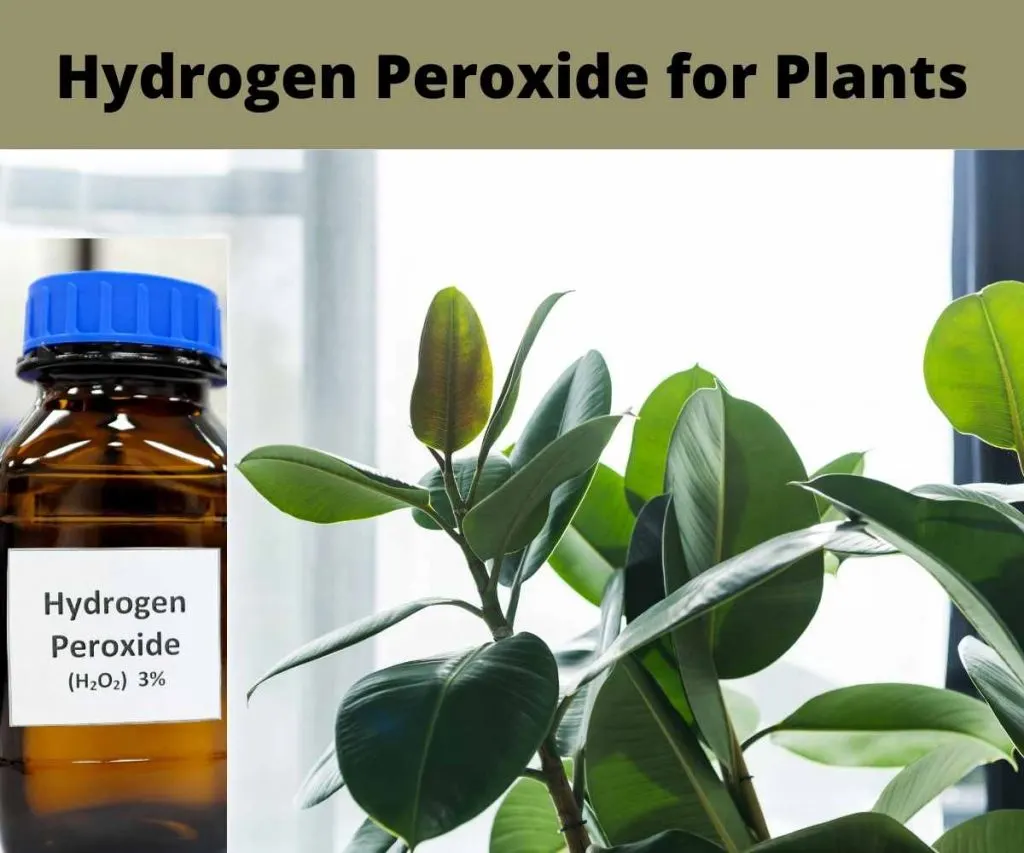
Adding hydrogen peroxide to water promotes better growth in plants and boosts roots ability to absorb nutrients from the soil. Diluted 3% peroxide adds needed aeration to the soil of plants and helps control fungus in the soil.
For indoor plants use 3% peroxide rather than stronger concentrations. It is safer and easier to use than more concentrated solutions.
What are the Benefits of Hydrogen Peroxide?
This powerful oxygenator helps plants in several ways. Here are three Major benefits for your housplants.
Hydrogen Peroxide…
- Encourages and supports Plant growth by supplying oxygen into the soil. Plants absorb more nutrients and grow faster.
- Eliminates soil fungus spores and molds. In fact it can sterilize soil of all pathogens.
- Kills fungus gnats when used as a soil drench and deters sap sucking insects when regularly applied as a leaf spray.
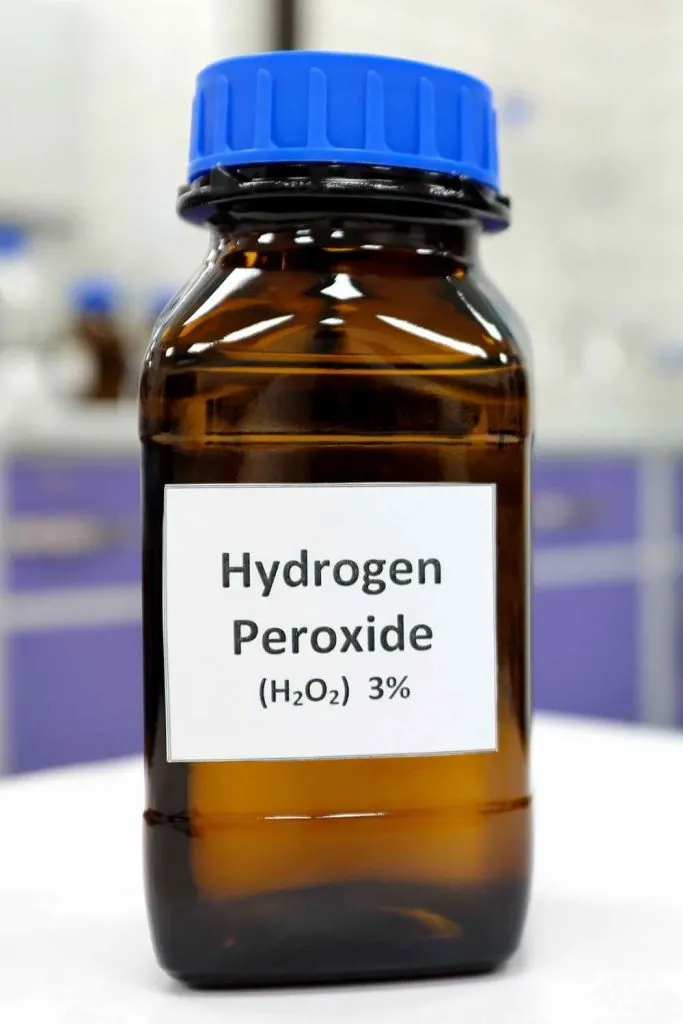
How much 3% Hydrogen peroxide Do I Use?
Use 3% hydrogen peroxide for plants in these dilutions to help your plants:
- For misting Indoor plants mix 1 tsp./ cup of water. This improves aeration to your plant and deters fungus on leaves and soil. The ratio here is one part 3% hydrogen peroxide to 48 parts water.
- To help kill pests on the plant leaves like Aphids, spider mites and other sapsuckers use the misting solution above.
- Ratio of 3% hydrogen peroxide to water is 1 part h202 to 8 parts water. This is a solution for example of 1 pint Hydrogen peroxide/gallon of water. It is safe to pour as a drench around your plant roots to sanitize the soil of fungus and other pathogens. Pour the solution into the plant pot around the roots and let the pot sit overnight to drain.
- Mix 1 1/2 Tablespoons baking soda and 1 1/2 tablespoons 3% peroxide with 2 and a half gallons (approximately 9.46 liters) of water for a powerful homemade anti fungal solution that can be sprayed directly on the plant leaves. This is helpful in getting rid of powdery mildew and other leaf spot diseases.
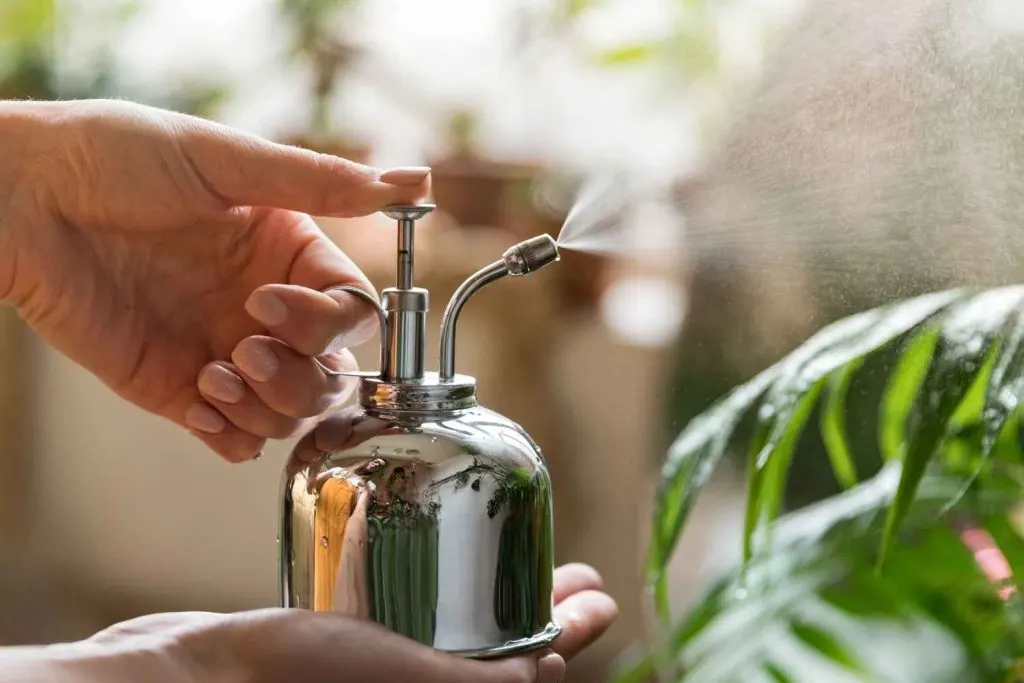
To Help Fix Root Rot:
Applying Hydrogen peroxide aerates waterlogged plant roots . The improved oxygen circulation to plant roots can save roots in danger of root rot. And those in the early stages. Hydrogen Peroxide will kill the pathogens that cause the rot.
Drench the soil with 1 part 3% peroxide/ two parts water to kill off the bacteria causing the rot in your soil. Let the plant drain completely.
Waterlogged roots cause a Lack of oxygen to the roots. The roots will suffocate and eventually die. Hydrogen Peroxide properly applied can help.
This will also help immediately deliver much needed oxygen to the plant roots and kill off bad bacteria in the decaying roots.
I wrote a whole post on how to fix root rot and another on 7 reasons your plants has Yellowing leaves. We all run into these common overwatering problems in houseplants from time to time.
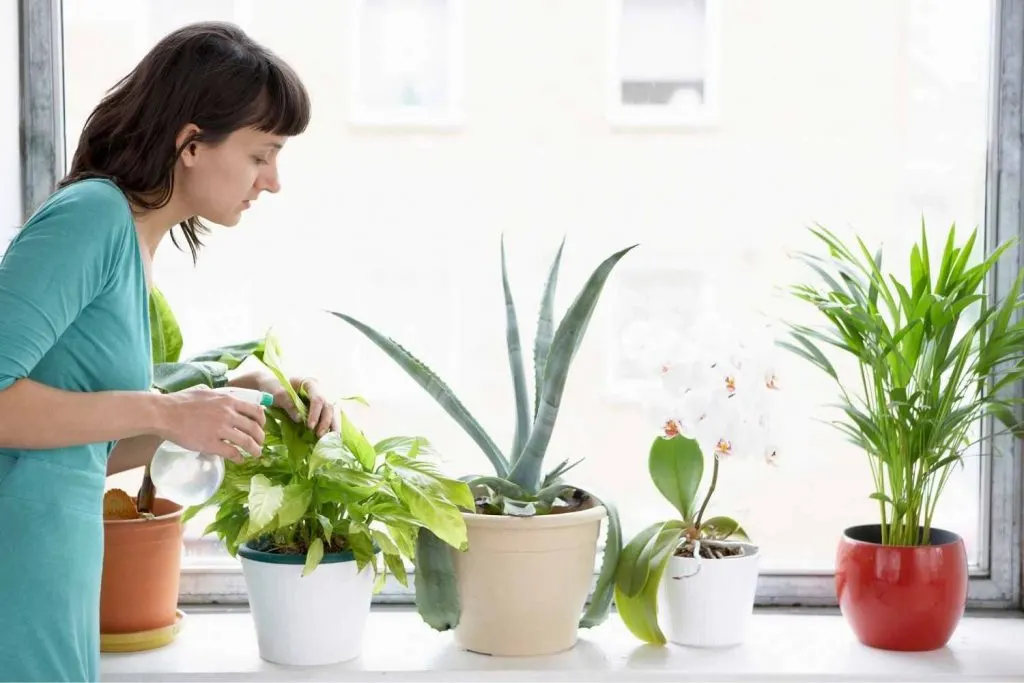
To Effectively and Safely Use Hydrogen Peroxide:
Hydrogen peroxide works very quickly… and then quickly breaks down. After it loses its oxygenating properties the benefits of using it are gone. SO you need to mix up your solution for your purpose and then immediately use it to gain the best benefits.
If you want to make a solution and keep it long term it must be stored in a dark water tight container in a cool place.
Never leave hydrogen peroxide where kids and pets can get into it.
At higher concentrations you should wear gloves when working with hydrogen Peroxide. At 3% the solution is safe for normal handling with your houseplants.
Follow Us:
Find us on YouTube, Instagram , Pinterest and TikTok! We love to Plant chat. We also comment, like and occasionally share your content to our daily stories. We’d love to see your plants. Share your joy in your houseplants. Happy Planting!
Recent Posts:
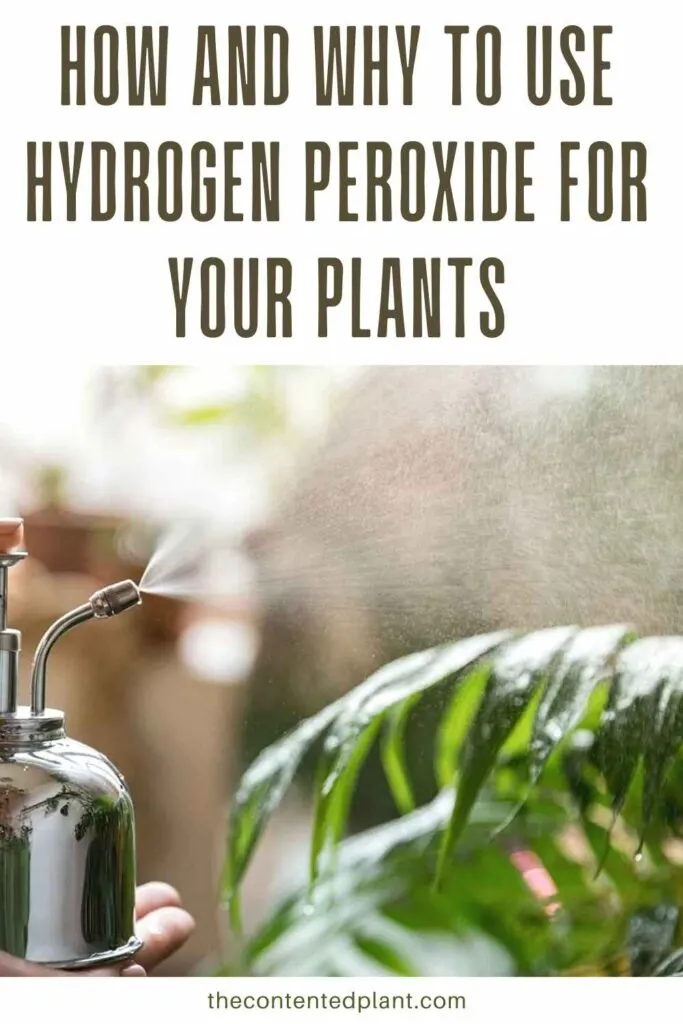

Hydrogen Peroxide for Indoor Plants: Benefits & Usage Tips (2024)
Wednesday 24th of January 2024
[…] of treatment with hydrogen peroxide depends on the individual plant’s needs. According to The Contented Plant, some plants may benefit from weekly treatments, while others may only require treatment every few […]
Jojo
Sunday 6th of August 2023
Hey there! Thank you for the information. I have a schefflera plant clipping stored in water, that turns it cloudy. Can adding hydrogen peroxide help or another solution to control the acidity of the plant stem.
Diane Williams
Monday 14th of August 2023
Hi JoJo, Cloudiness in the water of your schefflera plant clipping is more likely due to the growth of bacteria or other microorganisms rather than acidity. Hydrogen peroxide can indeed control bacterial growth and maintain water clarity, but it's important to use it correctly to avoid harming the plant. Here's what you can do:
Prepare a Solution: Mix a very diluted solution of hydrogen peroxide and water. A common ratio is 1 part hydrogen peroxide to 3-5 parts water. For example, you could use 1 teaspoon of 3% hydrogen peroxide (the type commonly found in drugstores) per cup of water. Set aside. Remove the Clipping: Take the schefflera clipping out of the cloudy water. Gently wash the clipping to remove any bacteria. If the stem is showing sliminess or rot. You may have to clip the end if it is dissolving and unrooted. Clean the Container: Clean the container you were using for the water. Wash it thoroughly to remove any residual bacteria or contaminants. You may need to bleach it to kill off bacteria. It needs to be really clean. Add the Solution: Pour the diluted hydrogen peroxide solution into the clean container. Reinsert Clipping: Place the schefflera clipping back into the container with the diluted hydrogen peroxide solution. Monitor and Maintain: Keep an eye on the water and the cutting. If the water starts to become cloudy again, replace it with a fresh batch of the diluted hydrogen peroxide solution. Remember that while hydrogen peroxide can help control bacterial growth, be sure the cutting is also getting enough light, and the container isn't kept in a place where it receives too much direct sunlight, as this could lead to overheating and further bacterial growth.
Another alternative to control bacterial growth is to use activated charcoal. Activated charcoal can help absorb impurities and prevent cloudiness in the water. Simply add a small piece of activated charcoal to the water container.
Nick
Saturday 25th of March 2023
Hi Diane,
Thank you for the informative article. What would happen if you (accidentally) spray the plants (seedlings/plantlings) with 3% hydrogen peroxide directly? Didn't dilute it before spraying due to excitement :(
Please help, thank you! And have a nice day :)
yours sincerely,
Nick
Diane Williams
Monday 27th of March 2023
Hi Nick, Spraying the hydrogen peroxide directly on the plant is not a good idea. If you can directly following that accident I would spray the plants liberally with water to wash it off. If the plant is going yellow...it may be too late. Hopefully they will make it through. My husband killed his pepper plants this way. Best of luck!
Kelly Beatty
Thursday 16th of February 2023
regarding the anti-fungal mixture of water, baking soda, and H2O2, which is it: 4 liters or 2½ gallons (because 4 liters is just a tad more than 1 gallon)
Diane Williams
Friday 24th of February 2023
The conversion of gallons to liters in the given solution is correct. 2 and a half gallons are equivalent to approximately 9.46 liters. The conversion factor for converting gallons to liters is 1 US gallon = 3.78541 liters. Therefore, 2.5 US gallons can be converted to liters as follows:
2.5 US gallons x 3.78541 liters/US gallon = 9.46353 liters
Rounded to two decimal places, the result is approximately 9.46 liters. So, mixing 1 1/2 tablespoons of baking soda and 1 1/2 tablespoons of 3% hydrogen peroxide with 2 and a half gallons (approximately 9.46 liters) of water should produce the correct concentration of the solution.
This is a powerful antifungal solution that can be sprayed directly on the plant leaves, But be careful here. My husband sprayed it on his (already sick and heavily infested with spider mites) pepper plants and they died. It is essential to mix the solution properly and apply it carefully to avoid any damage to the plant.
It is always recommended to conduct a small test on a small area of the plant to ensure that the solution does not cause any harm or discoloration. I hope this helps!
Nikki
Monday 6th of February 2023
Is there a H202 out there that is exactly 3% already or are you making it 3% by adding the water to it? I have only found it at around 70% to 100%.
Josh
Monday 19th of June 2023
@Nikki, the 70% and 100% you’ve found is probably isopropyl alcohol. 3% H2O2 is typical for “home use”; 35% is considered “food grade”; and anything above 50% is considered “industrial use”
Diane Williams
Sunday 12th of February 2023
Hi Nikki, 3% hydrogen peroxide is available on amazon, in grocery stores and pharmacies. It is sold as antiseptics for wound care in 3 % dilution. I hope this helps!